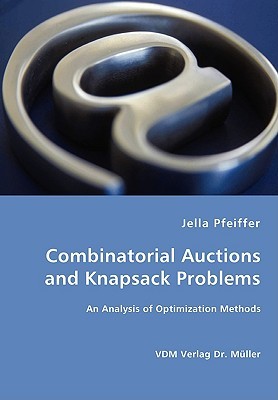
- We will send in 10–14 business days.
- Author: Jella Pfeiffer
- Publisher: VDM Verlag Dr. Mueller E.K.
- Year: 2007
- Pages: 128
- ISBN-10: 3836450062
- ISBN-13: 9783836450065
- Format: 17 x 24.4 x 0.7 cm, minkšti viršeliai
- Language: English
- SAVE -10% with code: EXTRA
Combinatorial Auctions and Knapsack Problems - An Analysis of Optimization Methods (e-book) (used book) | bookbook.eu
Reviews
Description
With the rapid diffusion of the internet, different kinds of market designs for e-commerce have emerged. Among these, combinatorial auctions (CAs) have gained increased interest as they permit bidders to express their valuations more easily. For applying a CA in real world scenarios, fast algorithms are needed to compute the optimal allocation of the offered goods. Although much research has dealt with this so-called Winner Determination Problem (WDP), only recently has its equivalence to the well-studied multi-dimensional knapsack problem (MDKP) been noticed. Therefore, there is a lack of research which compares approaches for solving MDKP and WDP problems. With this work, the author, Jella Pfeiffer, provides the missing integrative step, aiming at a more intense understanding and a mutual inspiration of both research areas. She examines structural differences of test instances from both domains, compares the performance of different algorithms, and alludes to a successful search behavior of non-exact but fast algorithms. The book addresses readers interested in electronic market design and algorithms solving complex combinatorial optimization problems.
EXTRA 10 % discount with code: EXTRA
The promotion ends in 23d.05:18:59
The discount code is valid when purchasing from 10 €. Discounts do not stack.
- Author: Jella Pfeiffer
- Publisher: VDM Verlag Dr. Mueller E.K.
- Year: 2007
- Pages: 128
- ISBN-10: 3836450062
- ISBN-13: 9783836450065
- Format: 17 x 24.4 x 0.7 cm, minkšti viršeliai
- Language: English English
With the rapid diffusion of the internet, different kinds of market designs for e-commerce have emerged. Among these, combinatorial auctions (CAs) have gained increased interest as they permit bidders to express their valuations more easily. For applying a CA in real world scenarios, fast algorithms are needed to compute the optimal allocation of the offered goods. Although much research has dealt with this so-called Winner Determination Problem (WDP), only recently has its equivalence to the well-studied multi-dimensional knapsack problem (MDKP) been noticed. Therefore, there is a lack of research which compares approaches for solving MDKP and WDP problems. With this work, the author, Jella Pfeiffer, provides the missing integrative step, aiming at a more intense understanding and a mutual inspiration of both research areas. She examines structural differences of test instances from both domains, compares the performance of different algorithms, and alludes to a successful search behavior of non-exact but fast algorithms. The book addresses readers interested in electronic market design and algorithms solving complex combinatorial optimization problems.


Reviews